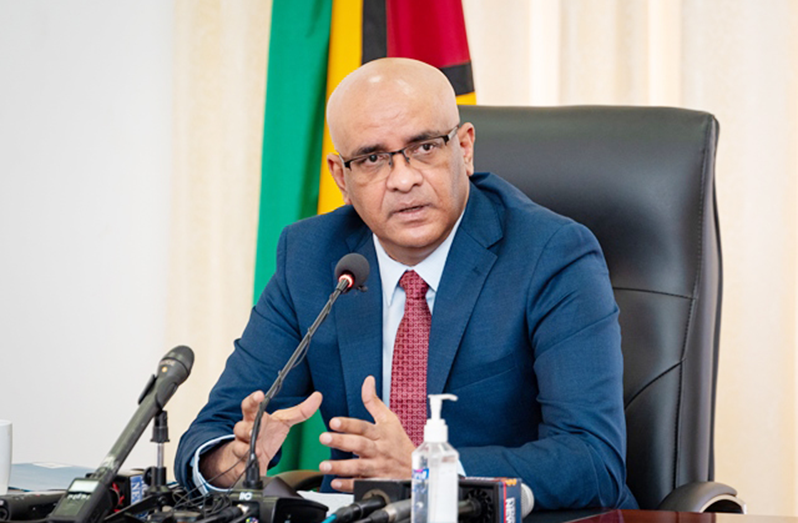–Vice-President Jagdeo contrasts gov’t’s ‘development agenda’ with APNU+AFC’s ‘consumption philosophy’
USING the capital provisions in the previous A Partnership for National Unity + Alliance For Change (APNU+AFC) government’s budgets for the basis of his argument, Vice-President Dr. Bharrat Jagdeo contended that there would be no future had the country employed the philosophy of the coalition in the management of Guyana’s economy.
“To understand the budget and the starting point from the two competing sides, we have to go back to the financial philosophy of the two parties… often when we accuse PNC, APNU+AFC of being a consumption-based party, we mean one that does not prepare for the future, one that taxes and spends in a particular manner,” Vice-President Jagdeo said during a press briefing at the Arthur Chung Conference Centre, on Thursday.
The Vice-President used budgets prepared by People’s Progressive Party/Civic (PPP/C) governments and those prepared by APNU+AFC to justify his claim that the coalition has a “consumption philosophy.”
In 2014, the then PPP/C government had presented a budget valuing $220 billion, with current provisions of $138 billion and capital, $81 billion. In contrast, with the exception of its 2015 budget, none of the coalition’s capital provisions from 2016 to 2019 exceeded the PPP/C’s 2014 capital provisions, although the overall appropriation increased substantially.
On the current side of the budget, there was a 67 per cent increase between 2014 and 2019, with the budgeted sum moving from $138 billion to $231 billion. For the same period, capital provisions declined from $81 billion in 2014 to $69 billion in 2019.
“Capital spending is where you build your schools, hospitals, roads, bridges, sea defences… this was accorded very little priority [by APNU+AFC] … if you do not have port facilities, roads, power, then you cannot have long-term growth in the economy,” Vice-President Jagdeo reasoned, adding that every economy needs to invest in a major way to have long-term growth.
He went on to say: “Current expenditure includes money for rentals of buildings, vehicles, other stuff, goods and services that you cannot see… the capital things we would have seen them.”
The coalition’s ratio of current to capital expenditures, in Jagdeo’s view, proves why the party is consumption based and why its philosophy does not consider future growth.
“If we had continued with their philosophy, we would end up consuming everything we earn, with no provisions for the future,” Vice-President Jagdeo said.
Even in the reported absence of provisions to drive development, the coalition reportedly sought to restrict individual growth by imposing heavy taxes on the citizenry. Within the APNU+AFC’s tenure, tax revenues grew from $135 billion to $225 billion.
On the contrary, the PPP/C government, this year, managed to compile the country’s largest budget without imposing any new taxes. The $552.9 billion Budget 2022, which is funded partly by oil revenues, sets aside $335 billion for current expenditures and $217 billion for capital works.
“That is building for the future… we are spending our money on the future wellbeing, investing in things the country would be able to see and touch,” Jagdeo related.
In his view, the capital provisions tell the story of PPP/C governments and the story of the transformation of Guyana.
“It shows why we did so well without oil and gas from the period we took office [1992], when the debt overhand was nine times that of our economy; to service debt we used 153 per cent of our revenue and when we left office [in 2014] we were using less than 10 per cent… and through that, we had invested in roads, schools and so on,” Vice-President Jagdeo said.
He contended that APNU+AFC, after being elected to office in 2015, immediately adopted the “consumption philosophy,” which was utilised in the 1980s, that led to Guyana becoming one of the most heavily indebted countries in the world.
Unlike their philosophy, he believes that the PPP/C’s focus on capital projects would be ideal amidst the generation of oil revenues.
“If you spend on the capital side and you have a downturn in oil, you can scale back… the cost is not recurrent… that is why, right from the beginning, we made it clear that we shall not make the mistake of other countries,” Dr. Jagdeo related, adding: “We cannot splurge on things that do not bring future benefits.”
KEY MEASURES
This year, in addition to a wide range of public investment projects and initiatives which will stimulate economic activity, create jobs, and thereby generate incomes, Budget 2022 proposes specific measures aimed at providing support to both businesses and households, with the same objectives of job creation and income generation and, ultimately, improving well-being.
Among those measures is a planned increase in the monthly income tax threshold from $65,000 to $75,000 monthly, thereby releasing a total of $1.3 billion into the hands of current taxpayers both in the public and private sectors.
Another significant measure which would benefit persons in the low-income bracket is the increase of the loan ceiling from $12 million to $15 million. This will make housing loans from commercial banks more affordable to borrowers within the low-income range, and help encourage persons who now have a house lot to proceed to borrow and build.
The government will also increase old-age pension to $28,000, placing an additional $2.3 billion of disposable income in the hands of 65,000 pensioners.
Added to this, there are plans to increase the monthly public assistance payment from $12,000 to $14,000, benefitting 18,000 persons and providing an additional $432 million in disposable income to those individuals.
Specifically on benefits for the youth, the government will increase the uniform voucher to $5,000 and increase the “Because We Care” cash grant to $25,000 per child.
Another “cost of living measure” is the allocation of $5 billion to address rising commodity prices. The specific use of those funds will be identified following consultations with communities.



.jpg)









